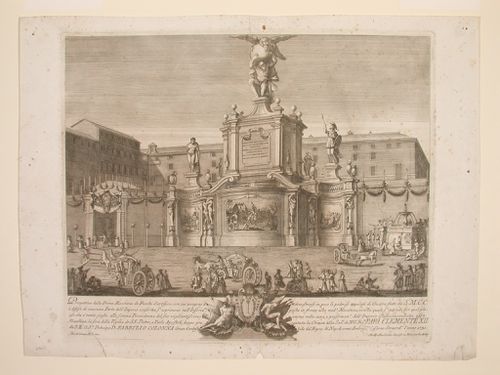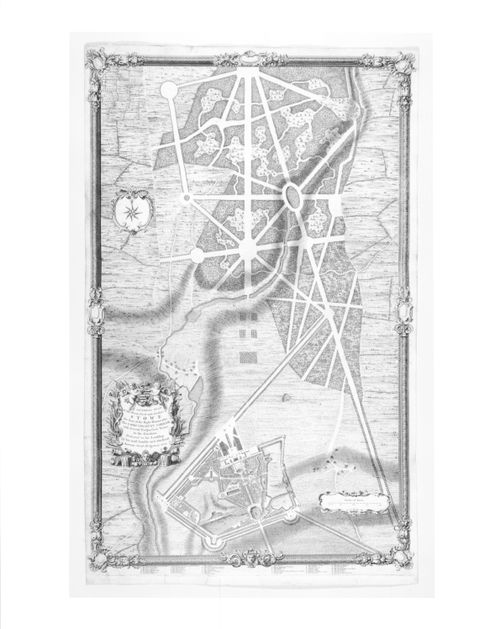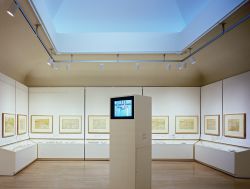DR1988:0437:005
Description:
- This etching for a fireworks construction or macchina is set against the courtyard wall of the Palazzo Colonna. The macchina is three stories in height: the basement level is attached to the wall of the Palazzo Colonna and includes three depictions of military scenes. The second level contains an inscription dedicated to Charles VI, Holy Roman Emperor, which is flanked by statues of Hercules and Minerva. The top level includes a statue of Atlas carrying the globe surmounted by the imperial eagle.
architecture temporaire
printed 1731
Etching of Michetti's design for the "prima macchina" of 1731
Actions:
DR1988:0437:005
Description:
- This etching for a fireworks construction or macchina is set against the courtyard wall of the Palazzo Colonna. The macchina is three stories in height: the basement level is attached to the wall of the Palazzo Colonna and includes three depictions of military scenes. The second level contains an inscription dedicated to Charles VI, Holy Roman Emperor, which is flanked by statues of Hercules and Minerva. The top level includes a statue of Atlas carrying the globe surmounted by the imperial eagle.
architecture temporaire
Sous-série
AP140.S2.SS1.D60.SD1
Description:
This sub-project series documents an executed project for the Clore Gallery in London, England. This addition to the Tate Gallery (now Tate Britain) was built to house the Turner Bequest. Material in this Sub-file was produced between 1978 and 1990. The sub-project series contains design development drawings, including several for an early feasibility study for phased additions to the Tate Gallery, including the Clore Gallery, planned on the Queen Alexandra Military Hospital site to the east of the main building. It also contains presentation drawings produced for publication purposes, as well as a large number of working drawings. Photographic materials includes views of models by John Donat Photography, and of the building site and the completed building, including several by photographers Richard Bryant, Alastair Hunter, J. Okun and Mary Shand (Lady Mary Stirling). A large quantity of textual records and two models are also present in the sub-project series.
1978-1990
Clore Gallery, London, England, United Kingdom
Actions:
AP140.S2.SS1.D60.SD1
Description:
This sub-project series documents an executed project for the Clore Gallery in London, England. This addition to the Tate Gallery (now Tate Britain) was built to house the Turner Bequest. Material in this Sub-file was produced between 1978 and 1990. The sub-project series contains design development drawings, including several for an early feasibility study for phased additions to the Tate Gallery, including the Clore Gallery, planned on the Queen Alexandra Military Hospital site to the east of the main building. It also contains presentation drawings produced for publication purposes, as well as a large number of working drawings. Photographic materials includes views of models by John Donat Photography, and of the building site and the completed building, including several by photographers Richard Bryant, Alastair Hunter, J. Okun and Mary Shand (Lady Mary Stirling). A large quantity of textual records and two models are also present in the sub-project series.
Sub-series
1978-1990
General plan of Stowe
DR1982:0096:001
Description:
- A plan (with legend) of Stowe gardens (defined by an irregular pentagon at the bottom of the print), together with the layout of the forest garden stretching north beyond the garden boundry and containing long intersecting rides cut through the woodlands. An elaborate cartouche (lower left), formed of military paraphernalia, encloses a dedication to Viscount Cobham, owner of the property. - The marbled and leather-edged portfolio in which the prints were acquired is stored separately in a solander box (size IV).
architecture, architecture de paysage
designed ca. 1738
General plan of Stowe
Actions:
DR1982:0096:001
Description:
- A plan (with legend) of Stowe gardens (defined by an irregular pentagon at the bottom of the print), together with the layout of the forest garden stretching north beyond the garden boundry and containing long intersecting rides cut through the woodlands. An elaborate cartouche (lower left), formed of military paraphernalia, encloses a dedication to Viscount Cobham, owner of the property. - The marbled and leather-edged portfolio in which the prints were acquired is stored separately in a solander box (size IV).
architecture, architecture de paysage
Projet
AP178.S1.1995.PR12
Description:
This project series documents the design for the Instituto de Biofísica in Hombroich, Germany. While the records were held in the office’s archives this project was assigned the number 69/90. The office assigned the dates 1995-1996 to this project. The project was commissioned by the Insel Hombroich Foundation. Construction started in 1995, but was delayed until 2006. The project site was located on an old military camp and was used by the Foundation as part of a program for architects to build different types of building. The program for the Institute of Biophysics included office spaces, conference rooms, a meditation center, a music center and five guest apartments. Siza's design was kept and used later with a different interior layout for a new Pavilion for the Insel Hombroich Foundation (see project series AP178.S1.2001.PR02 in this fonds). The project was a collaboration with Rudolf Finsterwalder. Documenting this project are studies and working drawings. Textual materials include project documentation, correspondence and a development plan.
1991-2011
Instituto de Biofísica [Institute of Biophysics], Hombroich, Germany (1995-1996)
Actions:
AP178.S1.1995.PR12
Description:
This project series documents the design for the Instituto de Biofísica in Hombroich, Germany. While the records were held in the office’s archives this project was assigned the number 69/90. The office assigned the dates 1995-1996 to this project. The project was commissioned by the Insel Hombroich Foundation. Construction started in 1995, but was delayed until 2006. The project site was located on an old military camp and was used by the Foundation as part of a program for architects to build different types of building. The program for the Institute of Biophysics included office spaces, conference rooms, a meditation center, a music center and five guest apartments. Siza's design was kept and used later with a different interior layout for a new Pavilion for the Insel Hombroich Foundation (see project series AP178.S1.2001.PR02 in this fonds). The project was a collaboration with Rudolf Finsterwalder. Documenting this project are studies and working drawings. Textual materials include project documentation, correspondence and a development plan.
Project
1991-2011
Série(s)
AP162.S7
Description:
Series documents the contribution of architect Hans Scharoun to the correspondence circle of Die gläserne Kette, with Scharoun writing under the pseudonym Hannes. Born in 1893 in Bremen, Germany, Scharoun studied archictecture at the Technische Hochschule at Berlin-Charlottenburg between 1912 and 1914. From 1915 to 1918 he worked on a military commission for the rebuilding of East Prussia. In 1919, he joined the Arbeitsrat für Kunst led by Bruno Taut. From 1919 to 1925 he worked independently, taking on private and public commissions as well as architectural projects for exhibitions. He taught at the Akademie für Kunst und Gewerbe in Breslau from 1925 to 1932, and at the Technische Universität Berlin as a town planning professor from 1946 to 1958. In 1956, he won the first prize of the competition for the Philharmonie concert hall in West Berlin. He died in Berlin in 1972. (Source: Ian Boyd Whyte, Bruno Taut and the Architecture of Activism. Cambridge: Cambridge University Press, 1982) The series comprises part of the correspondence of Hans Scharoun to the Die gläserne Kette circle and related drawings.
between 1919 and 1920
Hans Scharoun
Actions:
AP162.S7
Description:
Series documents the contribution of architect Hans Scharoun to the correspondence circle of Die gläserne Kette, with Scharoun writing under the pseudonym Hannes. Born in 1893 in Bremen, Germany, Scharoun studied archictecture at the Technische Hochschule at Berlin-Charlottenburg between 1912 and 1914. From 1915 to 1918 he worked on a military commission for the rebuilding of East Prussia. In 1919, he joined the Arbeitsrat für Kunst led by Bruno Taut. From 1919 to 1925 he worked independently, taking on private and public commissions as well as architectural projects for exhibitions. He taught at the Akademie für Kunst und Gewerbe in Breslau from 1925 to 1932, and at the Technische Universität Berlin as a town planning professor from 1946 to 1958. In 1956, he won the first prize of the competition for the Philharmonie concert hall in West Berlin. He died in Berlin in 1972. (Source: Ian Boyd Whyte, Bruno Taut and the Architecture of Activism. Cambridge: Cambridge University Press, 1982) The series comprises part of the correspondence of Hans Scharoun to the Die gläserne Kette circle and related drawings.
series
between 1919 and 1920
archives
Niveau de description archivistique:
Fonds
Fonds Maxwell Levinson
AP037
Résumé:
The Maxwell Levison fonds (Shelter, T. Square) illustrates primarily the activities of Maxwell Levinson as editor of T-Square Club Journal, T-Square, Shelter and USA Tomorrow. It documents the various aspects of the publication of these magazines. It includes editorial, production and promotional material as well as documentation and research files. The fonds also contains records pertaining to the professional practice of Maxwell Levinson as architect and city planning consultant.
1926-1990
Fonds Maxwell Levinson
Actions:
AP037
Résumé:
The Maxwell Levison fonds (Shelter, T. Square) illustrates primarily the activities of Maxwell Levinson as editor of T-Square Club Journal, T-Square, Shelter and USA Tomorrow. It documents the various aspects of the publication of these magazines. It includes editorial, production and promotional material as well as documentation and research files. The fonds also contains records pertaining to the professional practice of Maxwell Levinson as architect and city planning consultant.
archives
Niveau de description archivistique:
Fonds
1926-1990
documents textuels
AP140.S1.SS2.P1
Description:
Certificate of post-war credit awarded to "J. F. Stirling" for the year ending 5 April 1946, dated 5 November 1948; letter from Peter G. Halpreaves (Liverpool University Contingent Senior Training Corps) to James Stirling, dated 16 June 1944, regarding Stirling`s letter discussing his military service and injury; letter from Professor L.B. Budden (Liverpool School of Architecture) to James Stirling, dated 1 February 1951, responding to Stirling`s statement of having "no intention of taking part in any future war, nor service relating to war" and his medical status
1948-1951
Certificate of post-war credit
Actions:
AP140.S1.SS2.P1
Description:
Certificate of post-war credit awarded to "J. F. Stirling" for the year ending 5 April 1946, dated 5 November 1948; letter from Peter G. Halpreaves (Liverpool University Contingent Senior Training Corps) to James Stirling, dated 16 June 1944, regarding Stirling`s letter discussing his military service and injury; letter from Professor L.B. Budden (Liverpool School of Architecture) to James Stirling, dated 1 February 1951, responding to Stirling`s statement of having "no intention of taking part in any future war, nor service relating to war" and his medical status
documents textuels
1948-1951
archives
Niveau de description archivistique:
Fonds
Fonds Arthur Erickson
AP022
Résumé:
The Arthur Erickson fonds documents the work and activities of Canadian architect Arthur Erickson between 1947 and 2002 (predominant dates 1963-ca. 2000). It comprises architecture projects records with three hundred ninety-seven projects by Erickson / Massey, Arthur Erickson Architects and Arthur Erickson as a design consultant are documented with drawings, photographs, textual documents and other material. It also includes project administration records, records from Erickson's Toronto, Los Angeles and Vancouver offices, records related to Erickson's professional activities, material related to some of Erickson's student projects, and personal papers.
1947-2002 (predominant 1963-2000)
Fonds Arthur Erickson
Actions:
AP022
Résumé:
The Arthur Erickson fonds documents the work and activities of Canadian architect Arthur Erickson between 1947 and 2002 (predominant dates 1963-ca. 2000). It comprises architecture projects records with three hundred ninety-seven projects by Erickson / Massey, Arthur Erickson Architects and Arthur Erickson as a design consultant are documented with drawings, photographs, textual documents and other material. It also includes project administration records, records from Erickson's Toronto, Los Angeles and Vancouver offices, records related to Erickson's professional activities, material related to some of Erickson's student projects, and personal papers.
archives
Niveau de description archivistique:
Fonds
1947-2002 (predominant 1963-2000)
Série(s)
AP162.S5
Description:
Series documents the contribution of architect Carl Krayl to the correspondence circle of Die gläserne Kette, with Krayl writing under the pseudonym Anfang. Born in 1890 in Weinsberg, Germany, Krayl worked on building sites between 1906 to 1909 in preparation for the architectural studies he would undertake from 1910 to 1912 at the Kunstgewerbeschule and the Polytechnikum at Stuttgart. He was employed as a military architect during the First World War and was stationed at Ingolstatd. After the war, Krayl joinded the Arbeitsrat für Kunst lead by Bruno Taut. Between 1919 to 1921 he contributed to "Frühlich", a magazine published by Taut which featured works by some members of Die Gläserne Kette. Krayl joined Bruno Taut in the city architecture department at Magdeburg. From 1923, he worked independently and executed private and public architectural projects. During the Nazi regime he worked as a draftsman for the German State Railway from 1938 to 1946. He died in 1946 in Werder an der Havel, Germany. (Source: Ian Boyd Whyte, Bruno Taut and the Architecture of Activism. Cambridge: Cambridge University Press, 1982) The series comprises part of Carl Krayl's correspondence to the Die gläserne Kette circle, along with related drawings and photographs.
1918-1945
Carl Krayl
Actions:
AP162.S5
Description:
Series documents the contribution of architect Carl Krayl to the correspondence circle of Die gläserne Kette, with Krayl writing under the pseudonym Anfang. Born in 1890 in Weinsberg, Germany, Krayl worked on building sites between 1906 to 1909 in preparation for the architectural studies he would undertake from 1910 to 1912 at the Kunstgewerbeschule and the Polytechnikum at Stuttgart. He was employed as a military architect during the First World War and was stationed at Ingolstatd. After the war, Krayl joinded the Arbeitsrat für Kunst lead by Bruno Taut. Between 1919 to 1921 he contributed to "Frühlich", a magazine published by Taut which featured works by some members of Die Gläserne Kette. Krayl joined Bruno Taut in the city architecture department at Magdeburg. From 1923, he worked independently and executed private and public architectural projects. During the Nazi regime he worked as a draftsman for the German State Railway from 1938 to 1946. He died in 1946 in Werder an der Havel, Germany. (Source: Ian Boyd Whyte, Bruno Taut and the Architecture of Activism. Cambridge: Cambridge University Press, 1982) The series comprises part of Carl Krayl's correspondence to the Die gläserne Kette circle, along with related drawings and photographs.
series
1918-1945
*Montréal, ville fortifiée du XVIIIe siècle* explore l’évolution de la ville au XVIIIe siècle, alors qu’elle était une ville fortifiée. Cet événement offre une occasion unique de se renseigner sur l’essor de la ville commerciale et militaire à l’origine de la métropole actuelle. Couronnant presque quinze années de recherche et la création d’une(...)
Salles principales
8 septembre 1992 au 28 février 1993
Montréal, ville fortifiée au XVIIIe siècle
Actions:
Description:
*Montréal, ville fortifiée du XVIIIe siècle* explore l’évolution de la ville au XVIIIe siècle, alors qu’elle était une ville fortifiée. Cet événement offre une occasion unique de se renseigner sur l’essor de la ville commerciale et militaire à l’origine de la métropole actuelle. Couronnant presque quinze années de recherche et la création d’une(...)
Salles principales


